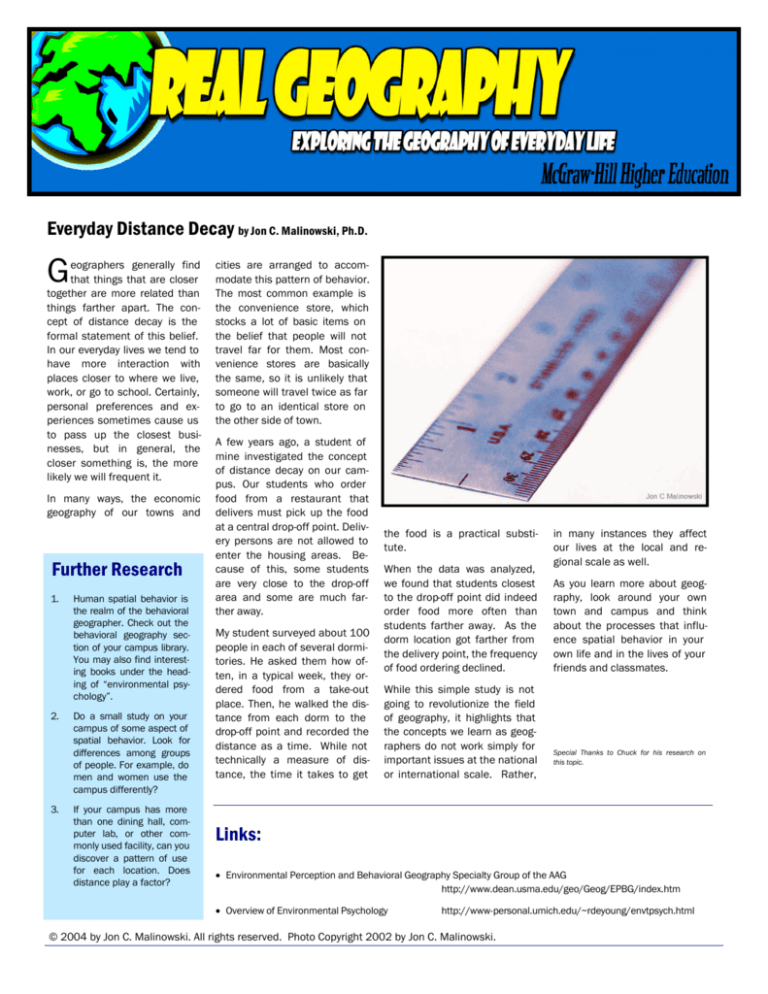
Everyday Distance Decay by Jon C. Malinowski, Ph.D.
G
eographers generally find
that things that are closer
together are more related than
things farther apart. The concept of distance decay is the
formal statement of this belief.
In our everyday lives we tend to
have more interaction with
places closer to where we live,
work, or go to school. Certainly,
personal preferences and experiences sometimes cause us
to pass up the closest businesses, but in general, the
closer something is, the more
likely we will frequent it.
In many ways, the economic
geography of our towns and
Further Research
1.
2.
3.
Human spatial behavior is
the realm of the behavioral
geographer. Check out the
behavioral geography section of your campus library.
You may also find interesting books under the heading of “environmental psychology”.
Do a small study on your
campus of some aspect of
spatial behavior. Look for
differences among groups
of people. For example, do
men and women use the
campus differently?
If your campus has more
than one dining hall, computer lab, or other commonly used facility, can you
discover a pattern of use
for each location. Does
distance play a factor?
cities are arranged to accommodate this pattern of behavior.
The most common example is
the convenience store, which
stocks a lot of basic items on
the belief that people will not
travel far for them. Most convenience stores are basically
the same, so it is unlikely that
someone will travel twice as far
to go to an identical store on
the other side of town.
A few years ago, a student of
mine investigated the concept
of distance decay on our campus. Our students who order
food from a restaurant that
delivers must pick up the food
at a central drop-off point. Delivery persons are not allowed to
enter the housing areas. Because of this, some students
are very close to the drop-off
area and some are much farther away.
My student surveyed about 100
people in each of several dormitories. He asked them how often, in a typical week, they ordered food from a take-out
place. Then, he walked the distance from each dorm to the
drop-off point and recorded the
distance as a time. While not
technically a measure of distance, the time it takes to get
the food is a practical substitute.
When the data was analyzed,
we found that students closest
to the drop-off point did indeed
order food more often than
students farther away. As the
dorm location got farther from
the delivery point, the frequency
of food ordering declined.
While this simple study is not
going to revolutionize the field
of geography, it highlights that
the concepts we learn as geographers do not work simply for
important issues at the national
or international scale. Rather,
in many instances they affect
our lives at the local and regional scale as well.
As you learn more about geography, look around your own
town and campus and think
about the processes that influence spatial behavior in your
own life and in the lives of your
friends and classmates.
Special Thanks to Chuck for his research on
this topic.
Links:
• Environmental Perception and Behavioral Geography Specialty Group of the AAG
http://www.dean.usma.edu/geo/Geog/EPBG/index.htm
• Overview of Environmental Psychology
http://www-personal.umich.edu/~rdeyoung/envtpsych.html
© 2004 by Jon C. Malinowski. All rights reserved. Photo Copyright 2002 by Jon C. Malinowski.




